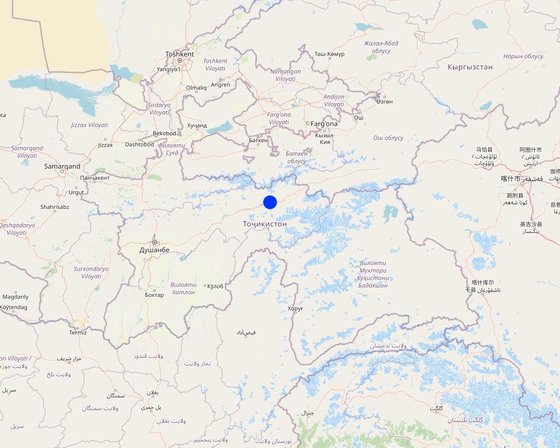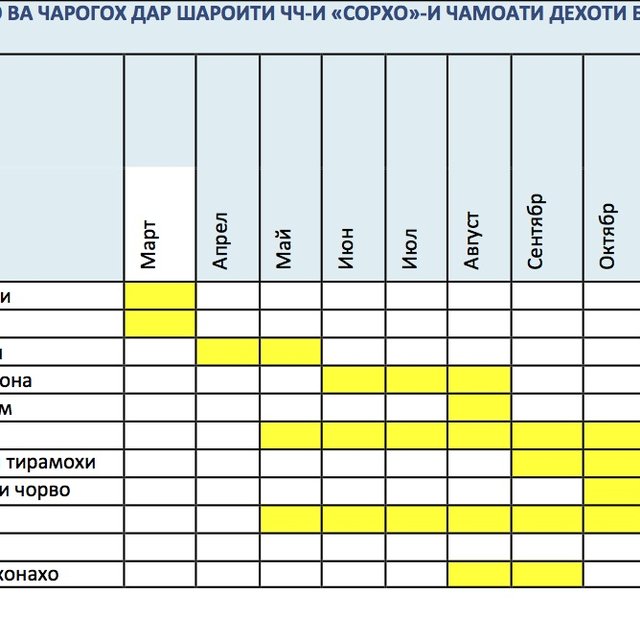Pasture Calendar
(Tajikistan)
Таквими чарогохистифодабари
Description
Pasture calendar services the PUU as part of the implementation of the plan with a specific timeframe and activities. It helps communities in designing intervention with regard to the need of agreed activities in the calendar.
Pasture calendar is a composition of different activities and events within the PLMP of the PUU, where concrete timeframes for each events and activities are defined. PUUs were supported to develop their pasture calendar with specific activities related to pasture use and management with supervision of the PUU management. All the eight PUUs have their own pasture calendar, because the timeframes for each PUU is different. This is caused by different altitudes, that result in different timeframes for different events. For example in Jirgatal movements to the summer pastures start in May, in a lower district like Faizabad and Roghun it starts one or half a month earlier. This will help the PUUs to coordinate the livestock movement and applying different techniques in the right time. Another important element is that for each activity a responsible person or team is identified. Roles and responsibility are shared while considering gender aspects aswell. For example, specific tasks in livestock and pasture management, where women's roles are more crucial enable them to participate in planning and decision making.
Location

Location: sub-district of D. Aliev, PUU Sohru at sub-district level, Rasht Valley/Faiobod District, Tajikistan
Geo-reference of selected sites
Initiation date: n.a.
Year of termination: n.a.
Type of Approach
-
traditional/ indigenous
-
recent local initiative/ innovative
-
project/ programme based

Pasture Calendar sample of the Sorho PUU (Zevarshoev Askarsho)
Approach aims and enabling environment
Main aims / objectives of the approach
The main aim of this approach is to organize activities within the given timeframe on pasture management. In this example support was provided to PUU to identify and plan the activities in a structured way for sustainable pasture management.
Conditions enabling the implementation of the Technology/ ies applied under the Approach
-
Availability/ access to financial resources and services: No major financial resource is required, only the motivation of communities and PUU members is needed, however as part of the pasture planning workshop session, some resource are needed for organizing the workshop.
-
Institutional setting: The process is run by the legally registered institute - Pastue User Union established according to the Pasture Law.
-
Collaboration/ coordination of actors: Once the detailed activities on pasture use are identified collaboration with other involved stakeholders based on the analysis will take place.
-
Legal framework (land tenure, land and water use rights): PUU in the framework of Pasture Law of the Republic of Tajikistan is registered.
-
Knowledge about SLM, access to technical support: The project staff have pasture specialists who train and build the capacity of PUU members.
Conditions hindering the implementation of the Technology/ ies applied under the Approach
Participation and roles of stakeholders involved
Stakeholders involved in the Approach and their roles
| What stakeholders / implementing bodies were involved in the Approach? |
Specify stakeholders |
Describe roles of stakeholders |
| local land users/ local communities |
livestock owners, PUU members |
active participation in the identification of main activities related to pasture management |
| SLM specialists/ agricultural advisers |
project specialist |
provide technical support in development and design of pasture calendar |
| local government |
land committee, forestry department, agriculture deparment |
supervise the implementation plan, support with providing advisory services also |
Involvement of local land users/ local communities in the different phases of the Approach
none
passive
external support
interactive
self-mobilization
initiation/ motivation
The development of the calendar depends on the initiative of the other stakeholders. If there is no consent with others, it is possible it will not be implemented.
planning
It includes roles and responsibilities of different stakeholders, where an interactive approach is required for planning.
implementation
The pasture calendar reflects the whole range of activities which are planned to implement in a given timeframe. For the implementation of some of the activities some external support both financial and technical is required, which was provided by the project staff and funding from various sources, including government and internal community fund, as well as donor fudings.
monitoring/ evaluation
With the guidance from the project team, which also has monitoring and evaluation experts monitoring had been conducted jointly with PUUs member. In addition, the implementing agencies for the ELMARL project, such as MSDSP, have also their monitoring and evaluation departments which carried out monitoring aswell.
Decision-making on the selection of SLM Technology
Decisions were taken by
-
land users alone (self-initiative)
-
mainly land users, supported by SLM specialists
-
all relevant actors, as part of a participatory approach
-
mainly SLM specialists, following consultation with land users
-
SLM specialists alone
-
politicians/ leaders
Decisions were made based on
-
evaluation of well-documented SLM knowledge (evidence-based decision-making)
-
research findings
-
personal experience and opinions (undocumented)
Technical support, capacity building, and knowledge management
The following activities or services have been part of the approach
-
Capacity building/ training
-
Advisory service
-
Institution strengthening (organizational development)
-
Monitoring and evaluation
-
Research
Capacity building/ training
Training was provided to the following stakeholders
-
land users
-
field staff/ advisers
Form of training
-
on-the-job
-
farmer-to-farmer
-
demonstration areas
-
public meetings
-
courses
Subjects covered
Pasture management. preparation of the pasture calendar, land management
Advisory service
Advisory service was provided
-
on land users' fields
-
at permanent centres
by project staff and also specialist from land and pasture committee, environmental committee
Financing and external material support
Annual budget in USD for the SLM component
-
< 2,000
-
2,000-10,000
-
10,000-100,000
-
100,000-1,000,000
-
> 1,000,000
Precise annual budget: 198.0
World Bank and IFAD
The following services or incentives have been provided to land users
-
Financial/ material support provided to land users
-
Subsidies for specific inputs
-
Credit
-
Other incentives or instruments
Financial/ material support provided to land users
The ELMARL project financed by World Bank supported the PUUs with implementation of the pasture plan, including support with follow up on pasture calendar.
Impact analysis and concluding statements
Impacts of the Approach
No
Yes, little
Yes, moderately
Yes, greatly
Did the Approach empower local land users, improve stakeholder participation?
Sets exact timeframe with activities to follow on and contributes to sustainable management of pasture resources.
Did the Approach improve knowledge and capacities of land users to implement SLM?
In time implementation of activities also motivates and contributing to implement SLM successfully.
Did the Approach improve knowledge and capacities of other stakeholders?
Various training as part of the implementation of the approach were provided to the land users to enable them in development of this approach and implementation.
Did the Approach mitigate conflicts?
When communities developed their pasture calendar, they agreed on the planned activities among each other, which mitigated conflict.
Did the Approach empower socially and economically disadvantaged groups?
Especially women and youth were involved in preparing the pasture calendar and were actively involved in decision making.
Did the Approach improve gender equality and empower women and girls?
Women were involved in preparing the pasture calendar, where most of the planned activities implementation depended on women. In this process women were actively involved in making decision with regards to those activities where they were actively involved.
Main motivation of land users to implement SLM
-
increased production
-
increased profit(ability), improved cost-benefit-ratio
-
reduced land degradation
-
reduced risk of disasters
-
reduced workload
-
payments/ subsidies
-
rules and regulations (fines)/ enforcement
-
prestige, social pressure/ social cohesion
-
affiliation to movement/ project/ group/ networks
-
environmental consciousness
-
customs and beliefs, morals
-
enhanced SLM knowledge and skills
-
aesthetic improvement
-
conflict mitigation
Sustainability of Approach activities
Can the land users sustain what hat been implemented through the Approach (without external support)?
Conclusions and lessons learnt
Strengths: land user's view
-
straight forward, easy understandable/and potential for replicaiton
Strengths: compiler’s or other key resource person’s view
-
easy development and doable/brings together all stakeholders in one room to jointly plan their activities with regards to pasture and livestock management/can be applied by communities without external support
Weaknesses/ disadvantages/ risks: land user's viewhow to overcome
-
depends on all involved stakeholders
required to strengthen collaboration between different stakeholder
Weaknesses/ disadvantages/ risks: compiler’s or other key resource person’s viewhow to overcome
-
very theoretic and not easy to adjust to real implmentation and straight forward only reflects one steps
should be considered as integral part of the overall pasture and livestock management approach
References
Reviewer
-
Yacime Khadraoui
-
Maximilian Knoll
-
Joana Eichenberger
Date of documentation: Maart 25, 2018
Last update: Aug. 22, 2024
Resource persons
-
Askarsho Zevarshoev (askarsho2006@yahoo.com) - SLM specialist
-
Murod Ergashev (soil_m@rambler.ru) - SLM specialist
Full description in the WOCAT database
Documentation was faciliated by
Institution
- Aga Khan Foundation (AKF) - Switzerland
Project
- Environmental Land Management and Rural Livelihood Project
Key references
-
Pasture and Livestock Management of Pasture Use Unions Sorhu, Faizabad District, D. Aliev sub-district, Tajikistan: Zevarshoev Askarsho, free of cost
Links to relevant information which is available online



